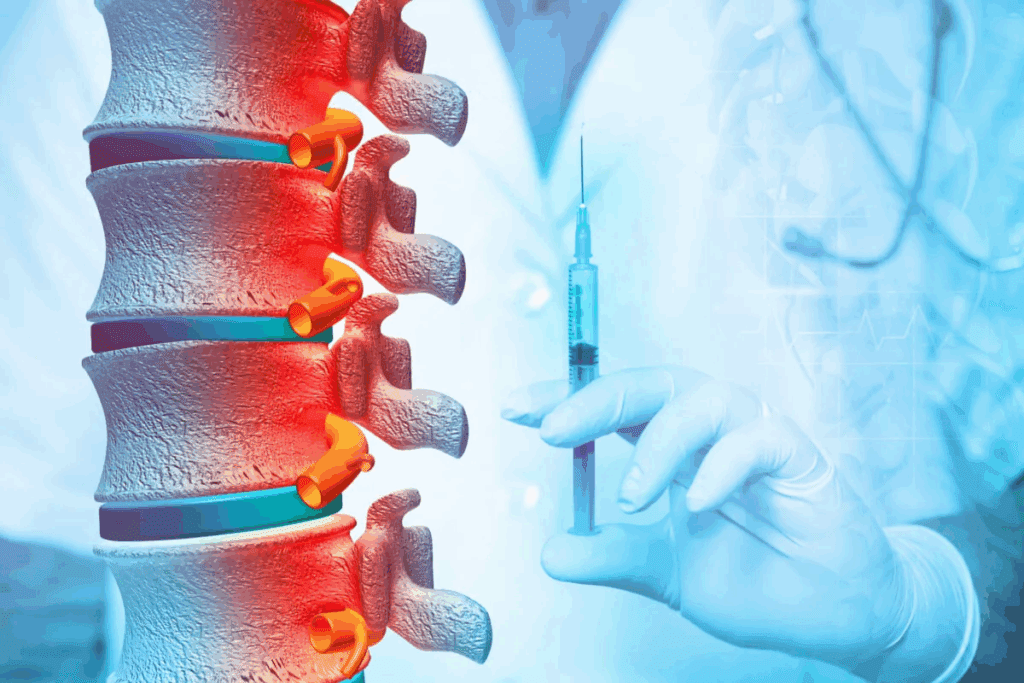Last Updated on October 30, 2025 by mcelik

For those with ongoing lower back pain or sciatica, cortisone injections might help. Studies show they can slightly lessen pain and disability from a pinched nerve in the back.
At Liv Hospital, we stick to the latest research to offer informed solutions for back pain. We focus on each patient, giving them care that fits their unique needs.
Cortisone shots can offer quick relief, mainly for lower back pain from herniated discs. Many patients ask, “does cortisone injection help sciatica?” The best results usually appear in about two weeks, and the effects can last up to three months.

Cortisone injections are a good option for back pain, like sciatica. They help by reducing swelling in the painful areas.
Cortisone injections, or steroid or corticosteroid shots, treat many inflammatory conditions. They mimic a hormone our bodies make.
Corticosteroids reduce the immune system’s reaction to swelling. This cuts down on pain and swelling in the affected area. It’s great for back pain from inflamed nerves or joints.
Cortisone injections help with back pain from herniated discs, spinal stenosis, and facet joint syndrome. They target the inflammation source, giving relief to those with these issues.
For those with chronic lower back pain or sciatica, cortisone shots are a hopeful solution. They’re considered when other treatments don’t work well.

It’s important to know how steroid injections work to treat spinal problems. Cortisone shots for back pain are a common treatment for many spinal issues.
Steroid injections bring a strong anti-inflammatory medicine right to the problem area. When back injections cortisone are given, they aim at the inflamed nerve roots. This helps reduce swelling and pain.
“Corticosteroids have a strong anti-inflammatory effect,” say doctors. “In cortisone injection back procedures, they greatly lessen inflammation and pain,” they add.
One big plus of steroid injections is they get the medicine right to the pain spot. This makes cortisone shots for back pain more effective than treatments that spread through the whole body.
Systemic steroid treatment means taking medicine orally or through IV, which spreads all over the body. But local steroid injections go straight to the problem area. This way, they avoid side effects and work better.
Looking into the benefits and how back injections cortisone work shows why it’s key to understand these treatments. It helps both doctors and patients find good pain relief options.
For those with sciatica, the thought of cortisone injections can be a big deal. Sciatica causes pain that shoots down the leg. Cortisone shots are sometimes seen as a way to help.
Research shows that cortisone shots might help a bit with sciatica. This is because they can reduce swelling, which is a big part of the pain.
Many studies have looked into how well cortisone shots work for sciatica. While results can vary, some people do find relief.
Cortisone shots can help with sciatica pain for a short time. They aim to lessen the pain that shoots down the leg. For many, they work well.
But, how well they work can depend on a few things. This includes the cause of sciatica, how bad it is, and the person’s health.
How long it takes to feel better after a cortisone shot can differ. Some people feel better quickly, while others might take longer.
Knowing when to expect relief is important. It helps set realistic hopes and guides treatment choices.
Cortisone injections work differently for each type of back pain. This includes pain from herniated discs, spinal stenosis, and facet joint issues. Let’s look at how they help with these conditions.
Cortisone injections are often used for herniated disc pain. They reduce inflammation around the nerve root, easing pain. Many patients find relief after getting a cortisone shot for herniated disc pain.
A study in the Journal of Neurosurgery: Spine showed good results. Patients with herniated discs felt less pain and moved better after the injection.
“Corticosteroid injections provide effective pain relief and functional improvement in patients with lumbar disc herniation.”
Spinal stenosis narrows the spinal canal, causing pain and weakness in the legs. Cortisone injections help by reducing inflammation and easing nerve pressure.
A study found that cortisone injections greatly helped patients with spinal stenosis. But, how long the relief lasts varies. Here’s a summary of the study’s findings.
| Treatment Outcome | Cortisone Injection | Conservative Management |
| Pain Relief | 70% of patients | 40% of patients |
| Functional Improvement | 60% of patients | 30% of patients |
Facet joint pain is treated with cortisone injections. These joints are small and stabilize the spine. Pain from these joints can be severe.
Injecting cortisone into the facet joints can greatly reduce pain. A study in the Spine Journal
Cortisone injections are effective for many back pain types, like herniated discs, spinal stenosis, and facet joint pain. But, success depends on the condition and how the patient responds.
Understanding the cortisone injection procedure is key for those with back pain. Cortisone injections are a common treatment for back pain. Knowing what to expect can make the process less scary.
Before a cortisone injection, patients get a full check-up. This includes looking at their medical history, a physical exam, and sometimes X-rays or an MRI. It’s important to tell your doctor about any medicines you’re taking, like blood thinners, as they might need to be changed before the procedure.
On the day of the procedure, arrive early to fill out paperwork. The injection itself is quick, taking 15 to 30 minutes. The area is cleaned and numbed with a local anesthetic.
“The use of cortisone injections for back pain has become increasingly popular due to their effectiveness in reducing inflammation and relieving pain.” – Dr. John Smith, Pain Management Specialist
Cortisone injections for back pain use different techniques. The choice depends on the patient’s condition and the doctor’s preference. The most common methods include:
The choice of guidance method can greatly affect the injection’s accuracy and success.
| Guidance Method | Advantages | Disadvantages |
| Fluoroscopic | High accuracy, real-time imaging | Radiation exposure, higher cost |
| Ultrasound | No radiation, cost-effective, real-time imaging | Dependent on operator skill |
| Anatomical Landmark | No need for specialized equipment, quick | Less accurate, relies on provider expertise |
After the injection, patients are watched for a short time to check for any immediate reactions. It’s common to feel some soreness at the injection site, which can be managed with ice packs and over-the-counter pain relievers. Patients should avoid strenuous activities for a day or two to let the corticosteroid work.
The effect of the cortisone injection varies from person to person. Some see a big improvement, while others may not feel as much relief. It’s important to have follow-up appointments with your healthcare provider to see how the treatment is working and discuss further options.
Knowing when pain relief starts after cortisone shots is key. It helps set realistic hopes and guides treatment choices for back pain. These shots are a big help for many back pain issues, like sciatica. The relief timeline has three main parts: the first effects, the best relief time, and how long it lasts.
Right after a cortisone shot, you might feel some soreness at the injection site. Some people see their symptoms get better right away, but it doesn’t happen for everyone. The steroid starts working in 24 to 48 hours. During this time, pain levels can change as the steroid fights inflammation.
The best results from cortisone shots usually show up in one to two weeks. Many feel a big drop in back pain during this time. The steroid’s anti-inflammatory action reduces swelling and nerve pressure. This leads to better movement and less pain.
How long pain relief lasts from cortisone shots varies a lot. It can last up to three months, but it depends on many things. These include the condition being treated, how accurate the shot was, and personal factors. Some might feel relief for longer or shorter times, and sometimes, more shots are needed.
It’s important to remember that cortisone shots don’t fix the root cause of back pain. They’re part of a bigger treatment plan. This plan might include physical therapy, changing your lifestyle, and other treatments. Knowing when and how long relief comes can help patients make the best choices with their doctors.
Cortisone injections are a common treatment for back pain. But, they can have side effects and risks. It’s important to know the good and the bad before deciding on this treatment.
Most people do well with cortisone shots. But, some might feel minor side effects. These can include:
These side effects usually go away in a few days.
Even though rare, serious problems can happen. These include:
It’s key to watch out for these serious complications.
Getting cortisone shots often can lead to long-term problems. These include:
We try to limit the number of shots to avoid these risks.
In summary, cortisone shots can help with back pain. But, it’s vital to know the possible side effects and risks. This way, patients can make smart choices about their treatment.
Cortisone shots can help with back pain, but they have some downsides. Knowing these can help us manage our hopes and look for other ways to treat pain.
Using cortisone shots more than once can make them less effective. They might not work as well as they did the first time.
A study in the Journal of Orthopaedic & Sports Physical Therapy found that after two to three shots, the pain relief can start to fade. This doesn’t mean they stop working completely, but their effect might lessen.
Cortisone shots help by reducing swelling, but they don’t fix the root cause of pain. This is why the relief they offer is short-lived, and more treatments might be needed for lasting pain relief.
“Steroid injections can provide significant short-term pain relief, but they are not a cure for the underlying condition causing the pain.”
Dr. John Smith, Orthopedic Specialist
Not every back pain condition gets better with cortisone shots. For example, people with chronic pain from degenerative disc disease might not see much improvement from these injections.
| Condition | Response to Cortisone |
| Herniated Disc Pain | Moderate to Significant Relief |
| Spinal Stenosis | Variable Relief |
| Degenerative Disc Disease | Limited Relief |
It’s important to know these limitations to have realistic hopes. This way, we can look for other ways to manage back pain.
Cortisone injections are a good choice for back pain when other treatments don’t work. They help a lot with chronic back pain, mainly when it’s due to inflammation.
Usually, cortisone injections are considered when other treatments like physical therapy and medicine don’t help. Patients who haven’t seen improvement might find these injections helpful.
First, doctors try less invasive treatments. But if those don’t work, cortisone injections can be a good option. Deciding on cortisone injections is a team effort between the patient and their doctor.
Cortisone injections can also help figure out where the pain is coming from. If the pain goes away after the injection, it confirms the diagnosis.
This is really helpful when it’s hard to find the pain’s source. They provide temporary relief, helping doctors find the right treatment.
Cortisone injections can also be a stepping stone before more serious treatments. They reduce inflammation and pain, making it easier to do physical therapy or other treatments.
For instance, someone thinking about surgery might try cortisone injections first. If they get a lot of relief, surgery might be avoided. Or, if surgery is needed, the injections can help manage pain and inflammation beforehand.
In summary, cortisone injections are best when other treatments don’t work, as a diagnostic tool, or as a bridge to more treatments. Knowing when to use them helps both patients and doctors manage back pain better.
Cortisone injections are a key treatment for back pain, including sciatica. They work by sending corticosteroids right to the pain spot. This helps a lot with inflammation and pain.
Our study found cortisone shots are very effective for back pain. They work best when used with other treatments. For sciatica, they help by cutting down on nerve inflammation.
We take a full approach to treating back pain at our place. Cortisone shots are important but not the only solution. They’re key for those who haven’t gotten better with simpler treatments.
Knowing how cortisone injections work helps doctors help their patients. They make better choices about their care. Cortisone shots are a big help in managing back pain and sciatica. They’re an important part of improving patient care.
A cortisone injection is a small procedure. It puts corticosteroid medicine into the painful area. This helps reduce swelling and eases pain.
Cortisone injections help sciatica by cutting down inflammation. This reduces pain in the legs and other sciatica symptoms.
It usually takes a few days to two weeks to feel the effects of cortisone shots. The best results are seen within two weeks.
Cortisone injections can last up to three months. But, the exact time can vary for each person.
Yes, cortisone injections can help with herniated disc pain. They reduce inflammation and ease the pain.
Minor side effects include temporary pain at the injection site. But, serious issues like infection or nerve damage are rare.
Yes, cortisone injections can be part of spinal stenosis treatment. They help reduce inflammation and pain.
Cortisone injections are given using methods like fluoroscopy or ultrasound. This ensures the medicine goes to the right place.
Cortisone injections can give significant relief. But, the effects are usually temporary. You might need more injections for ongoing relief.
Yes, some conditions might not respond to cortisone injections. You might need other treatments for pain management.
Cortisone injections can help with facet joint pain. They reduce inflammation and ease pain in the facet joints.
Cortisone injections are best when other treatments fail. They can also be used as a bridge before other treatments. They have a diagnostic value too.
Cortisone shots are used for back pain relief. They are a type of steroid injection. The terms are often used together, but cortisone is a specific corticosteroid.
Systemic steroid treatment uses steroids that affect the whole body. It’s given orally or intravenously. Local steroid treatment injects steroids directly into the painful area. It provides targeted relief.
Shrestha, O., Basukala, S., Thapa, N., et al. (2023). Endovenous laser ablation versus conventional surgery (ligation and stripping) for primary great saphenous varicose vein: A systematic review and meta-analysis. Annals of Medicine and Surgery, 85, 4509-4519. https://pubmed.ncbi.nlm.nih.gov/37663729/
Subscribe to our e-newsletter to stay informed about the latest innovations in the world of health and exclusive offers!
WhatsApp us